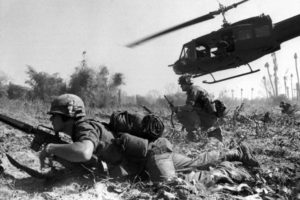From History News Network | Original Article
More than forty years after the Vietnam War, death and devastation continue to follow in its wake, and the misery index rises even though the shooting has long stopped. Richard Nixon once stated that no other American war was more “misunderstood, misreported or misremembered.” This may be true, but it is far more likely the men responsible for America’s years-long bloodbath in Vietnam would gladly have their miscalculations, failures in judgment and carelessness of deed attributed to misunderstanding, misreporting or, most laughable, misremembering. Historians, scholars, political scientists and high-level government officials have written volumes about the Vietnam experience. Careful examination of a representative sample of this material reveals a wealth of understanding, faithful reporting and documented recounting of events.
However interpreted, certain facts remain irrefutable and speak for themselves: 211,000 American men and women were killed or wounded on the battlefields of Vietnam, and 1,600 remain missing. Incredibly, estimates today range as high as 3,000,000 Vietnamese men, women and children and an additional 1,000,000 Cambodian/Lao killed or wounded.
Even today, at the onset of a new century, vast expanses of once productive Southeast Asian land continue to threaten the native population. Death, disease and disfigurement are embedded in the very soil under their feet. Records show between 1961 and 1971, the U.S. sprayed approximately 76,000,000 liters – 8,800 tons – of herbicide (Agents Orange, Green, Pink, Purple and White) over an area of 6,000,000 square acres – 14% of Vietnam’s land mass. Dioxins, the active family of chemicals in Agent Orange, are known health risks to humans. Sampling studies undertaken in the 1990’s revealed dangerously high levels of contaminant in Vietnamese forests, soil, fishpond sediment, fish and fowl tissue and human blood. Agent Orange Dioxin in human blood samples taken from Vietnamese men and women ranging from twelve to twenty-five years old clearly show the contaminant chemicals have moved up through the food chain into humans.
Even though science has only begun to catalogue the long-term effects of Agent Orange on the Vietnamese, the statistics are frightening. As early as 1970, Saigon’s leading maternity hospital reported a monthly average of 140 miscarriages and150 premature births in 2,800 pregnancies. As compared to others in the region, children living in areas sprayed with Agent Orange have been found to suffer three times as many cleft palates, three times as much mental retardation, are three times as likely to have extra fingers or toes and eight times as likely to experience massive abdominal and inguinal hernias. In addition, Vietnamese children born in sprayed areas suffered dwarfism, impaired vision, Down syndrome, heart disorders, enlarged heads and other deformities. Studies show severely affected children rarely lived beyond the age of twenty.
More is known about the effects of Agent Orange from treating American servicemen who were exposed to the poison in the course of their duties. Doctors treating veterans years after exposure have recorded a procession of life-threatening and life-diminishing symptoms. Vietnam veterans are far more likely to suffer immune system disorders, soft tissue sarcomas, non-Hodgkin’s lymphoma, respiratory cancers, liver disorders and even lower sperm counts. Children born to Vietnam veterans are more prone to birth defects relating to the nervous system, kidneys and oral clefts. Sudden Infant Death Syndrome is 400% more likely to occur in infants born to the men and women who served in Vietnam. Anecdotally, friends and family of Vietnam veterans tell story after story of their loved ones aging decades seemingly overnight. The veteran’s hair falls out in clumps and what remains turns white. Families report their veteran fathers, mothers, sons, daughters, brothers and sisters suffered from undiagnosed nerve disorders, irritability, weight loss, palsies and sometimes, sudden, unexplained death.
The Vietnam War misery index can be further expanded to include the estimated 100,000 men, women and children subsequently killed, maimed or mutilated by unexploded landmines, artillery, bombs, grenades and a variety of other ordnance that lay concealed in the forests and rice paddies of Vietnam,Cambodia and Laos. Routinely deployed by American and North and South Vietnamese forces, the troops considered booby traps and landmines barbaric but at the same time, necessary tools of war. In a published report, the U.S. Army stated that one third of all American wartime casualties were caused by landmines and booby traps; medical records show that 18.4% of injured servicemen and women underwent multiple amputations, compared with 5.7% in World War II.
Some three and a half million landmines remained armed and buried in Vietnam after the cessation of hostilities. Short on funds and organizational support, the Vietnamese government claims to have cleared 100,000 mines in recent years, but United Nations estimates are closer to 59,000. According to UN officials, landmines in Vietnam are a primary obstacle to its social and economic development.
In addition to landmines, Vietnam, Laos and Cambodia battle another type of unexploded ordinance that maims and kills. From 1969 to 1973, President Nixon conducted “secret” bombing raids on Cambodia. The exact tonnage of ordinance dropped remains disputed, but the four-year rain of fire sent millions of starving, homeless refugees into the cities and created an atmosphere of extremism that led to the Khmer Rouge atrocities known in the west as the killing fields.
In March 1964, five months before the first American bombing raid on North Vietnam, the United States organized a secret bombing campaign in Laos. Using unmarked planes, pilots initially attacked the Ho Chi Minh Trail, the increasingly important Communist supply route from North to South Vietnam. However, as the months passed, the air war intensified, and targets included Laotian villages, which drove a million peasants from their homes. For nine years, Laos was the most bombed country in the world. In 2004, Congresswoman Betty McCollum(D – MN) reported from the floor of the United States House of Representatives: “From 1964 to 1973, the U.S. flew 580,000 bombing runs over Laos – one every nine minutes for ten years. More than two million tons of ordnance was dropped on Laos, double the amount dropped in the European theater during the entirety of World War II. As many as thirty percent of the bombs dropped on Laos did not explode, leaving up to 20 million unexploded submunitions, also known as ‘bombies’ littered throughout the country. These American ‘bombies’ may be forty years old, but they continue to kill and maim children as well as farmers clearing land for planting. In the forty years since the end of the Vietnam War, an estimated 10,000 Lao people, including thousands of children, have died. And while Lao families struggle for food and survival, tens of thousands of acres of land cannot be put into agricultural production because the earth has been contaminated with this deadly cluster ordnance.”
Other victims of the Vietnam War included in the misery index are the friends, spouses, mothers, fathers, sons and daughters of the estimated 90,000 American veterans who committed suicide after the war and an equivalent number whose lives have been shattered by heroin and other hard drug use, which escalated rapidly and dramatically in the early 1970’s and was widely seen as stemming from the US military presence in Vietnam.
As much as any in our nation’s past, the Vietnam War’s negative effects on our society have rippled across the generations and to this very day continue to steal from “those who hunger and are not fed, those who are cold and not clothed,” to quote President Eisenhower. Someday perhaps, the way we look at war in our society will change. Someday perhaps, an informed and contemplative American citizenry will demand of its leaders full consideration of the true cost of armed conflict before permitting them to squander our most precious resource – our brave young men and women in service to America.
William Schroder is a Vietnam veteran and, with Dr. Ron Dawe, co-author of “Soldier’s Heart: Close-up Today with PTSD in Vietnam Veterans.”

